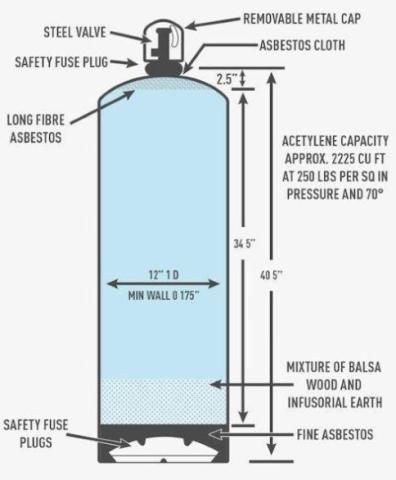Purpose
This safety alert provides information about asbestos found in imported acetylene cylinders.
Product description
NIR is a spectroscopic method that uses the near-infrared region of the electromagnetic spectrum (from about 350 nm to 2500 nm). Molecules within materials absorb specific wavelengths of NIR light energy and vibrate. The frequency of the vibration is compared to references of the vibration frequency for known materials, allowing identification of the unknown material.
Background
Testing identified asbestos in internal insulation (porous mass) in acetylene cylinders. The cylinders were manufactured and supplied by companies based in China. The Australian importer was advised by the China-based supplier that the cylinders were asbestos-free. A batch was tested in China in 2018 and the laboratory certificate stated the insulation did not contain asbestos. Another batch was tested in 2020 by a National Association of Testing Authorities (NATA) laboratory In Australia and was found to contain chrysotile asbestos.
Product description
Acetylene is a colourless gas which is widely used as a fuel and a chemical building block. It is the hottest of all fuel gases and is used in welding, plastics and acrylic acid derivatives and portable lighting. An acetylene cylinder has a different design from most other gas cylinders, with a steel shell containing a porous mass. Asbestos can sometimes be in the porous mass, and the neck and base of the cylinder.

Asbestos in imported products
The appropriate test method is by polarised light microscopy, including dispersion staining techniques in accordance with AS4964 (2004).
Risk control
The appropriate test method is by polarised light microscopy, including dispersion staining techniques in accordance with AS4964 (2004).
Testing requirements
The appropriate test method is by polarised light microscopy, including dispersion staining techniques in accordance with AS4964 (2004).
Managing the risk of asbestos in imported products
The Preventing goods or materials containing asbestos being supplied to workplaces in Queensland includes information on:
- how the importation of asbestos is regulated at the Australian border and the products at particular risk of containing asbestos
- what businesses must do to ensure imported products do not contain asbestos
- types of verifications that exist for Australian importers or consumers to show imported materials do not contain asbestos
- acceptable standards for testing if materials contain asbestos.